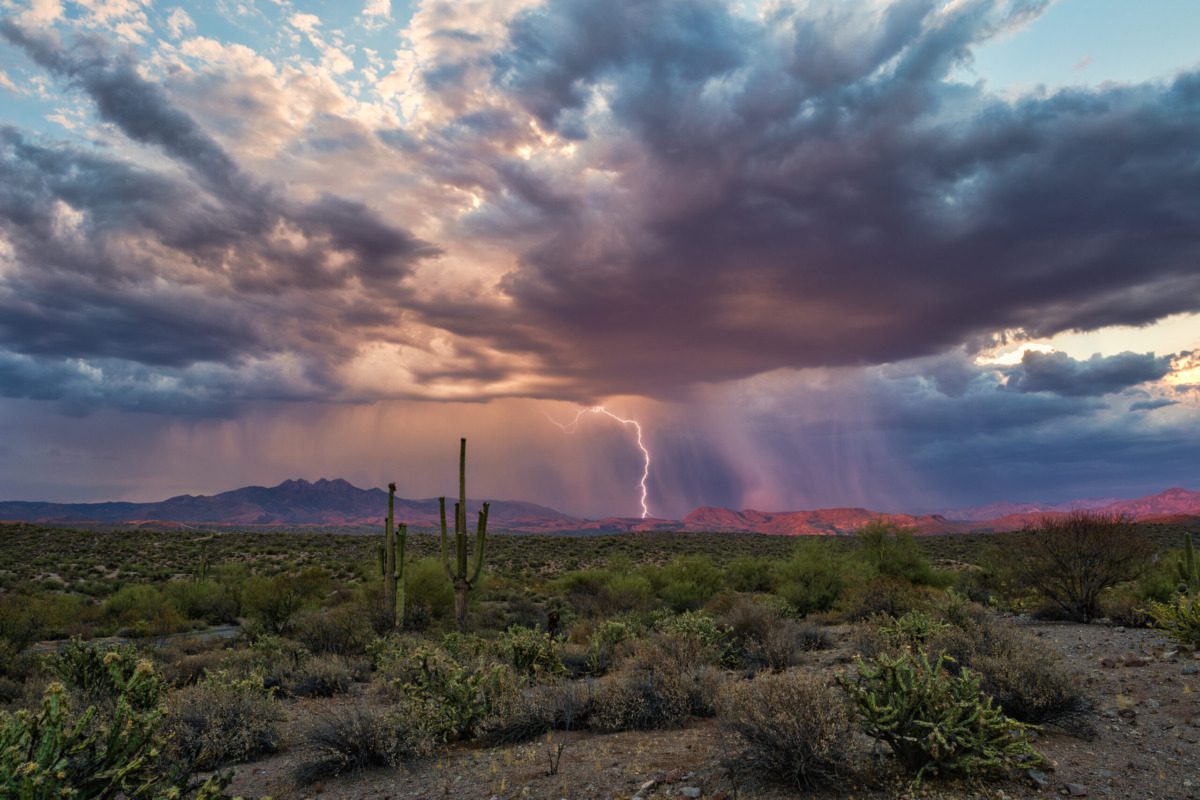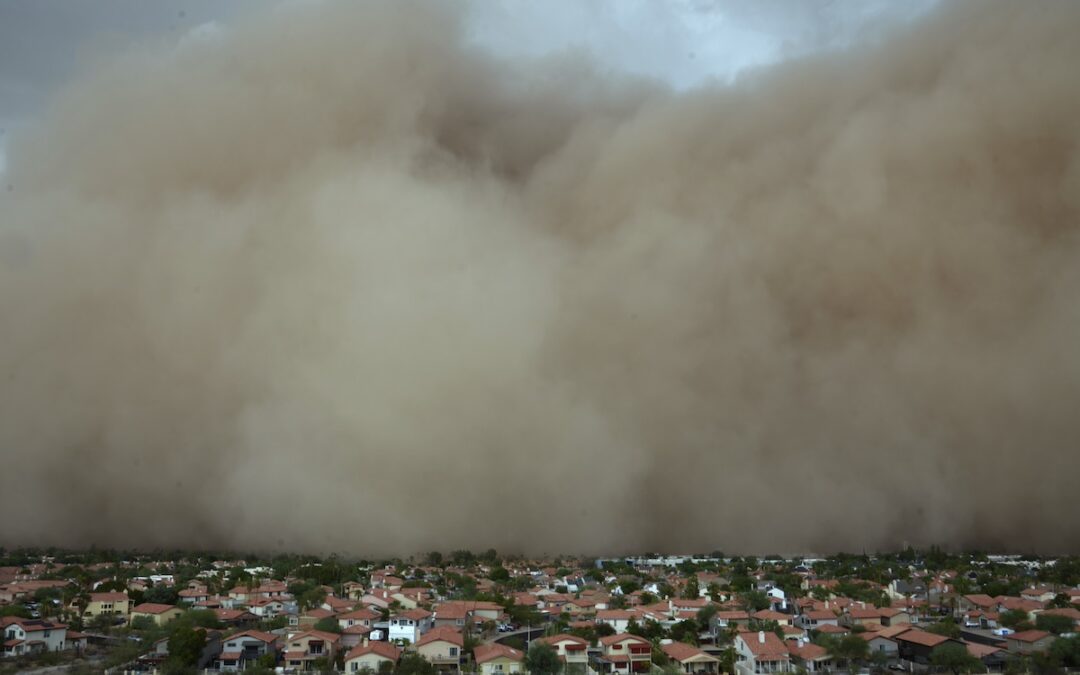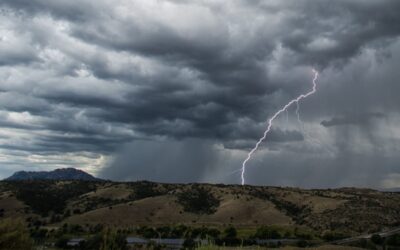
A monsoon moves across the Arizona desert. (John D Sirlin/Shutterstock)
Arizona’s monsoon season runs from June to September and often causes widespread devastation. Here are some of the most extreme monsoons in Arizona history.
It’s nearly impossible for me to hear the word “monsoon” without thinking of drag queen Jinkx Monsoon saying, “Get ready b*****s, cause it’s monsoon season!” when she won the fifth season of “RuPaul’s Drag Race.” It’s the easiest way to bring a sense of levity to a time that often leaves a trail of destruction in its wake.
AZ Central described monsoon season the best: “The monsoon isn’t just a meteorological phenomenon; it’s a season that defines summer … The smell of creosote after the first rain, lightning flickering across the sky and sudden evening downpours that flood dry washes are all quintessential for the summer months. But no two years are ever the same.” It’s this tendency for each year to be different that ultimately makes some monsoons more impactful than others. The season runs through Sept. 30 and may carry any number of dry or rainy conditions during this time.
The wettest monsoon on record occurred in 1984, whereas the driest one happened more recently, in 2023. This year, Arizona will likely see above-normal precipitation, but only time will tell if that proves to be true. While we wait to see what the next few months have in store for us, let’s take a closer look at some of the most extreme monsoons in Arizona history.
The Labor Day Storm of 1970
The Labor Day Storm of 1970 lasted from Sept. 4 through Sept. 5 and is still considered the deadliest storm in the state’s history. Remnants of tropical storm Norma caused severe flooding across Arizona, resulting in 23 deaths in the central portion of the state. Fourteen of those people died during flash floods in Tonto Creek, located near Kohl’s Ranch. At the time, many campers were trying to escape the storm and were helplessly swept away by a nearly 5-foot wall of water. The total recorded rainfall at Workman Creek was around 11.92 inches, with most of that rain (11.40 inches) falling within a 24-hour span.
In addition to the 11.92 inches that fell near Workman Creek, approximately 7 inches of rain were recorded at Crown King, 9 inches at Upper Park Creek, a little over 8 inches at Sunflower and Mount Lemmon, and about 7 inches near the Tonto Creek Fish Hatchery, which led to those deadly flash floods. As AZ Central storytelling reporter Shaun McKinnon notes, the death toll was particularly high as many people were out camping during the long Labor Day weekend.
Phoenix’s 1984 monsoon season
To date, the wettest monsoon season in Phoenix was recorded in 1984, when approximately 9.56 inches of rain fell across the city. That year also saw the most recorded monsoon days, with about 99 days registering a dew point of 55 degrees or higher. Adding to the extremity of the situation was the fact that 1984 also had the largest number of consecutive monsoon days, with a recorded 72 days between June 25 and Sept. 4.
According to the Phoenix New Times, “The only monsoon season after 1984 that cracked the top 10 list is 2014, when Phoenix saw 6.3 inches of rain.”
1962’s Tropical Storm Claudia
From Sept. 25 through Sept. 27, 1962, Tropical Storm Claudia caused severe flash floods in the Tucson area. Around 7 inches of rain poured over the desert west of the city, close to the Arizona-Sonora Desert Museum. These flood waters also spread into Sells and Marana. The remnants of this tropical storm caused about $8 million in damage in Arizona, with most of that amount attributed to a severe loss in crops during the flooding.
Additional damage to structures like dikes, spreader dams, and levees also took a financial toll. There was only one indirect death during this extreme weather event. Sixty-year-old Angela Bend is believed to have died of natural causes and was unable to receive medical care as ambulances couldn’t reach her home during the floods. About 27 families had to be rescued near Fort Huachuca via helicopter, and many cattle in the area unfortunately drowned.
Other devastating Arizona storms
Monsoons in Arizona have largely been less devastating in recent decades than they were in the past. That doesn’t mean that we’ve been safe from devastating storms, though. Numerous natural disasters have occurred over the years, with some of the most notable events taking place in 1891, 1983, 1997, and 2014.
The Great Flood of 1891 occurred from Feb. 19 to Feb. 26, following a major storm that caused the Salt River to overflow and flood Phoenix. Many businesses and homes were destroyed as a result. Additional damage was recorded in Mesa and Tempe, as the river stretched over 3 miles wide. The railroad bridge between Phoenix and Tempe was also destroyed, and it took nearly three months for rail service to resume. Thankfully, no one died during the floods, but around $125,000 in damage had been done (which would cost over $4 million in 2024).
Then, in 1983, the Autumn Floods caused 14 deaths and significant, widespread damage after the remains of Hurricane Octave swept through the state. Around 6.5 inches of rain fell around the Tucson basin over the course of five days. According to Pima County’s official website, “Damage to public infrastructure was estimated at $64 million, and four people died in flood-related incidents. Due to the magnitude and extent of flooding and related damage, this flood is the one to which subsequent floods have been compared.” Erosion and flood destruction were the worst along the Santa Cruz River, but additional damage had been done in Pantano Wash, Tanque Verde Creek, and Rillito Creek.
Similarly, in 1997, remnants of Hurricane Nora caused storms in western Arizona that resulted in flooding and record-breaking rainfall in Yuma. A state of emergency was declared in the county, and the Arizona National Guard was deployed shortly thereafter. As the storm moved into the area, it caused 45-60 mph winds that tore apart homes, businesses, and power lines. Around 12 inches of rain were reported on the Harquahala Mountains.
Then, in September 2014, Hurricane Norbert exacted its toll on the city of Phoenix. The storm brought extensive rainfall to the area (about a 1-in-1,000-year record!), which led to flash floods rivaling those from the Labor Day Storm of 1970. Two women died during the 2014 storm, one in Tucson and one in Pinal County, after their vehicles were washed away by floodwaters. The total damage from this storm was about $18 million across the state.
This article first appeared on Good Info News Wire and is republished here under a Creative Commons license.
RELATED: For older adults taking medications, summer heat can be especially dangerous

The hottest months in Arizona since 1895
In 2022, the continental United States experienced its third hottest July since 1895, according to data from the National Oceanic and Atmospheric...

Autumns in Phoenix are warmer than ever. What does the 2025 fall outlook say?
The calendar may say fall, but the weather tells a different story. In Phoenix, summer heat rarely ends on schedule. Forecasters say this fall will...

What to know about massive dust storms called haboobs in the US Southwest
Massive walls of dust and debris called haboobs that roll through the US Southwest can be awe-inspiring and terrifying, especially for motorists...

‘Fire clouds’ over Arizona and Utah wildfires are creating their own erratic climate
SALT LAKE CITY (AP) — Two wildfires burning in the western United States — including one that has become a “megafire” on the North Rim of the Grand...




